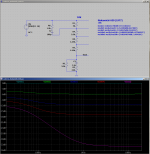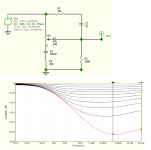Thanks for sharing, what are your speakers and relative room dimensions
8" two ways, room 20' x 20', speakers hung from the ceiling 8' above the floor.
Amplifier is a clone of Doug Self's "Blameless" amplifier.
It's a workshop with a high peaked ceiling. Acoustics are more like a basketball court than a living room. I did add some insulation to the overhead door (16' x7') which helped a whole lot. I noticed the sound was much better with the door open so I did that.
A thread that highlights real world scenarios for the performance and choices of our shelving and peaking filters
https://www.diyaudio.com/community/threads/lemme-shock-you.405508/post-7508887
https://www.diyaudio.com/community/threads/lemme-shock-you.405508/post-7518733
https://www.diyaudio.com/community/threads/lemme-shock-you.405508/post-7508887
https://www.diyaudio.com/community/threads/lemme-shock-you.405508/post-7518733
Nakamichi 630. Nice!Almost the first thing I did when this thread appeared was look up the Nakimichi 630, because I remembered its enigmatic 'Contour' control. According to the user manual it "Provides high and low frequency compensation for low listening levels.."
It seems to operate in much same way the usual centre-tapped-pot loudness control, but is configured rather differently. Two back-to-back electrolytics form the LF time constant, which I think rather iffy for distortion.
Attachments
8" two ways, room 20' x 20', speakers hung from the ceiling 8' above the floor.
Amplifier is a clone of Doug Self's "Blameless" amplifier.
I use 10 Blameless to drive my Linkwitz LX521.4 open baffle active speakers. I have used them for the last 10 years and they have not missed a beat. Solid design by Self.
Solid design by Self.
It's just a few extra transistors. So little does so much. That's good design.
Mine was supposed to be a prototype that I was going to scale up if it worked out. It's so good I've been using it for 6 years. Finally put it in a chassis.
This is my preference, as well. I never felt the need to use the loudness function on my previous pre setup.Two independent pots, one for volume and one loudness pot are ultimately more user friendly.
I was loaned a CX-600, and really disliked the loudness response curve. Much like the fixed tone control frequencies on consumer gear, it gave the impression of being designed with small speakers in mind, thus the bass enhance was set too high in frequency. It was also peculiar to use, since rotating the control subtracted the midrange. Overall, that model was a poor sounding preamp that lacked any sub-bass or clarity, like a bandpass filter.What is your impression of Yamaha gear that makes use of lowering the midrange only instead of boosting bass and treble?
Last edited:
Virtually word for word how Yamaha describes proper use of their continuously variable loudness control.From the 630 user manual:
CONTOUR
The normal position of this control is fully clockwise.... To use the contour control, first turn it fully clockwise. Turn up the volume control to normal maximum listening levels. Then turn the listening level down with the contour control instead of the volume control. loudness compensation will take place automatically.
So, two controls, as suggested by Adason.
I suspect many customers were confused and unimpressed with it (those who do not read user manuals), however it does precisely what it should do when it is used as intended; which is to apply more F/M curve at lower volumes and less at higher volumes.
Whether they "got it right" with respect to transition point frequencies is arguable, for sure.
This is my fully clockwise = "out of circuit" passive loudness circuit. it aims to track the difference between the curves of equal loudness charts. It works in combination with an analogue volume control in a preceding preamp stage. It feeds an active crossover which has that 100K input impedance. Motorised pots (loudness and volume). I did this many years ago before JRiver Media Center included a superior digital loudness compensator that is completely seamless and just works as you change the level with a different contour depending on the position of the 100 step 64 bit volume control. You can set the threshold for where it kicks in and can choose to allow it to touch treble or not. So this dinosaur has just stayed in the fully clockwise position for years along with the analogue volume control which has stayed at 12 o'clock. JRiver's digital "internal" volume and loudness is absolutely the way to go IMO. Wouldn't go back unless using other dinosaur stuff like LPs etc. but that would really be silly.
Attachments
Hmm ...
That is a much simpler circuit than what I had sketched in my head. I had envisioned splitting the audio into two paths. One would be a traditional preamp and the other an aggressive loudness filter. A 'contour pot' would then be used to pan progressively into the loudness. I had planned on using Mr Self's latest filters published in AudioXpress for the loudness section. Your circuit makes mine look overly complicated.
That is a much simpler circuit than what I had sketched in my head. I had envisioned splitting the audio into two paths. One would be a traditional preamp and the other an aggressive loudness filter. A 'contour pot' would then be used to pan progressively into the loudness. I had planned on using Mr Self's latest filters published in AudioXpress for the loudness section. Your circuit makes mine look overly complicated.
I've dabbled in the digital realm a few times in the past and have been generally disappointed in the results, but you've piqued my interest in JRiver. I might just give it a try. Does the 64-bit digital volume control manage to work without crushing DR?I did this many years ago before JRiver Media Center included a superior digital loudness compensator that is completely seamless and just works as you change the level with a different contour depending on the position of the 100 step 64 bit volume control. You can set the threshold for where it kicks in and can choose to allow it to touch treble or not. So this dinosaur has just stayed in the fully clockwise position for years along with the analogue volume control which has stayed at 12 o'clock. JRiver's digital "internal" volume and loudness is absolutely the way to go IMO. Wouldn't go back unless using other dinosaur stuff like LPs etc. but that would really be silly.
Also, I do use my dinosaur SL-10 every once in a while - so I'm fairly silly - but when I do I am actively listening at volumes loud enough that "loudness" isn't required. "Loudness" only comes into play when I'm using my digital source for BGM. JRiver might be the ticket.
Erm.... 64 bits is a truckload of dynamic range. And the figures only represent the size of the bucket - not how much water is in it. You could feed JRiver from LP using the WDM feature and an appropriate sound card/ phono preamp in Windows and the LP would sound just as bad as it did in the first place.
LOL (with you , not at you). Excuse my ignorance. It's just that my experience with digital volume control in the past has been very bad indeed. I'll keep my digital and analog sources independent of each other for now. I refuse to run Windows on my PCs so WDM is a no-go for me anyway. I appreciate your input and will give JRiver a test-drive soon.You could feed JRiver from LP using the WDM feature and an appropriate sound card/ phono preamp in Windows and the LP would sound just as bad as it did in the first place.
Perhaps this has been enough of a detour from this thread.
Last edited:
Well the only fully featured version of JRiver is the Windows version. Anyway you have an analogue circuit there that works. The schematic was knocked up for me by a retired Sydney Uni physics professor friend. I shared the circuit with a retired mastering engineer who worked for Columbia in Sydney in the 60s and 70s twiddling CBS recordings for Australian LP manufacture. He was sufficiently impressed hearing it work here to want to replicate it which he did. He is quite happy.
Last edited:
- Home
- Source & Line
- Analog Line Level
- Tone and Loudness Controls

